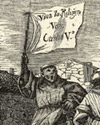19th Century´s militar history in the Basque Country
Txapelgorris
 This was the name given to the Volunteers of Gipuzkoa who defended the throne of Isabel II against the Carlists on the death of Ferdinand VII. They were called the txapelgorris because of the red beret that formed part of their uniform. The defenders of the cause of Don Carlos dubbed them the peseteros because they were paid one peseta a day by the Liberal government.
This was the name given to the Volunteers of Gipuzkoa who defended the throne of Isabel II against the Carlists on the death of Ferdinand VII. They were called the txapelgorris because of the red beret that formed part of their uniform. The defenders of the cause of Don Carlos dubbed them the peseteros because they were paid one peseta a day by the Liberal government.
The txapelgorris inspired deep hatred among their enemies because of their readiness to fight and because they knew the terrain as well as the Carlists themselves, thus eliminating the advantage that the latter normally had when fighting regular army troops.
The majority of the volunteers were townsfolk, mainly from towns such as San Sebastián, Tolosa, Ordizia and Eibar. However, as the txapelgorris could not recruit enough volunteers from Gipuzkoa, they had to recruit soldiers from other areas, including many from France. The Provincial Government of Gipuzkoa ordered that officials at the very last had to be recruited from the province.
Their first commander was Gaspar Jauregui "The Shepherd", former leader of the anti-Napoleon guerrilla forces in Gipuzkoa, who had returned from French exile to take on the responsibility. Over the first few months, the txapelgorris were active all around the province, contrasting in their avant-garde nature with the poorly organised Carlist troops.
 In the summer of 1834, they accompanied General Rodil, who succeeded Quesada at the command of the Northern Army, in his pursuit of the Pretender, and took part in the burning of the Sanctuary of Aránzazu. The majority of historians have exonerated the txapelgorris from blame for this fire, which was ordered by Rodil, furious that he could not catch up with Don Carlos and after accusing the Franciscan monks of conspiring with the Carlists. On this occasion, the txapelgorris acted on the orders of their second commander, Anselmo de Iñurrigarro.
In the summer of 1834, they accompanied General Rodil, who succeeded Quesada at the command of the Northern Army, in his pursuit of the Pretender, and took part in the burning of the Sanctuary of Aránzazu. The majority of historians have exonerated the txapelgorris from blame for this fire, which was ordered by Rodil, furious that he could not catch up with Don Carlos and after accusing the Franciscan monks of conspiring with the Carlists. On this occasion, the txapelgorris acted on the orders of their second commander, Anselmo de Iñurrigarro.
Francisco Lersundi formed part of this corps during the early stages of his long and brilliant military career. As a politician and man of state, he would later form several governments and lead the Moderate party.
 Towards the end of 1835, the txapelgorris were sent by orders of Iñurrigarro to Álava, where they came into conflict with Espartero. In December, a number of sacrilegious robberies were committed in the churches of La Bastida, Subijana, Ulibarri and Haro, of which the txapelgorris stood accused. Espartero rounded them up in Gamecha and, because he could not weed out the guilty parties, he ordered ten men to be shot at random and cast very strong accusations at the entire battalion of txapelgorris. Iñurrigarro was outraged and pleaded for help from Joaquin Maria Ferrer, a member of parliament for Gipuzkoa; the latter accused Espartero in the Cortes of getting ahead of himself by ordering the executions and hurling false accusations at the selfless txapelgorris.
Towards the end of 1835, the txapelgorris were sent by orders of Iñurrigarro to Álava, where they came into conflict with Espartero. In December, a number of sacrilegious robberies were committed in the churches of La Bastida, Subijana, Ulibarri and Haro, of which the txapelgorris stood accused. Espartero rounded them up in Gamecha and, because he could not weed out the guilty parties, he ordered ten men to be shot at random and cast very strong accusations at the entire battalion of txapelgorris. Iñurrigarro was outraged and pleaded for help from Joaquin Maria Ferrer, a member of parliament for Gipuzkoa; the latter accused Espartero in the Cortes of getting ahead of himself by ordering the executions and hurling false accusations at the selfless txapelgorris.
The Mayor of Lezo, a volunteer who was strongly admired by Iñurrigarro, was among those shot and just one more Guipuzcoan. The other victims were from Vizcaya, Castile, two from Navarre and four from France, which gives us an idea of the composition of the members of this army corps.

